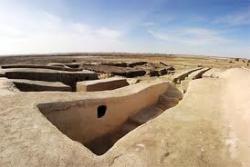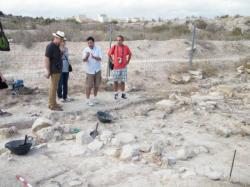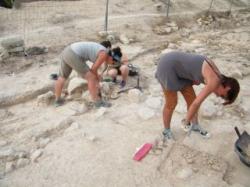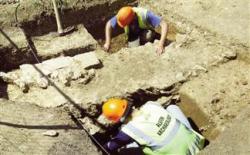- 01 AOÛT
- INDI-UNI : 
PRE-INSCRIPTION : 15 Juin – 15 Août
PRE-REGISTRATION: June 15th - August 15th
- IRAN –  Dahaneh Gholaman - Archeologists have unearthed an ancient palace dating back to the Achaemenid dynasty in Dahaneh Gholaman located in Iran's southeastern province of Sistan-Baluchestan. Comparing the structure in the Dahaneh Gholaman site with Achaemenid palaces in Takht-e Jamshid and Pasargaad proved that the newly-found site dates to the Achaemenid era, said Kourosh Mohammadkhani, leader of the archeological team. He added that the finding is the most significant achievement in the current phase of the recent study. The Dahaneh Gholaman site comprises of 54 ancient structures, most of which were discovered during the years 1959 and 2008. Takht-e Jamshid (Throne of Jamshid) or Persepolis was the ceremonial capital of the Achaemenid Empire (550-330 BCE) which is located in Iran's Fars Province. Pasargadae was also the capital of another Achaemenid king, Cyrus (559-530 BCE), and is the location of his tomb. Recent research has shown that Achaemenid engineers constructed the city to withstand a severe earthquake.
Dahaneh Gholaman - Archeologists have unearthed an ancient palace dating back to the Achaemenid dynasty in Dahaneh Gholaman located in Iran's southeastern province of Sistan-Baluchestan. Comparing the structure in the Dahaneh Gholaman site with Achaemenid palaces in Takht-e Jamshid and Pasargaad proved that the newly-found site dates to the Achaemenid era, said Kourosh Mohammadkhani, leader of the archeological team. He added that the finding is the most significant achievement in the current phase of the recent study. The Dahaneh Gholaman site comprises of 54 ancient structures, most of which were discovered during the years 1959 and 2008. Takht-e Jamshid (Throne of Jamshid) or Persepolis was the ceremonial capital of the Achaemenid Empire (550-330 BCE) which is located in Iran's Fars Province. Pasargadae was also the capital of another Achaemenid king, Cyrus (559-530 BCE), and is the location of his tomb. Recent research has shown that Achaemenid engineers constructed the city to withstand a severe earthquake.
http://www.presstv.ir/detail/191663.html
- ITALIE - Cuccuru e Lai - The astonishing discovery in the Sardinian countryside (Italy) of a small drystone wall entirely made of broken standing stones - many carved with stylised human figures - could make the site at Cuccuru e Lai, near Samugheo, one of the most important prehistoric sanctuaries of the island. Mauro Perra, archaeologist manager of the Villanovaforru Museum, said that the finding could be as important as the Mount Prama statues - a unique discovery with huge historical and scientific values. The broken standing stones date back to the Copper Age, or about 5000 years ago, and fit perfectly on the drystone wall, as they were probably broken up about 70 years ago, when the wall was built. Archaeologists started studying the area in the 1990s, when they made a dig near a giants tomb at Paule Lutturi; then in August 2008 they found a series of statue-menhirs (standing stones carved with human traits). Finally, this month a new dig led to the discovery of about 300 pieces of broken standing stones. "Around the 3rd millennium BCE, anthropomorphic statues spread throughout Europe. In Sardinia they can be found on Mandrolisai, Barigadu, at Laconi and Isili - in each area they have their own symbolic traits. Some of the stones discovered at Samugheo have carved faces, an inverted U and a central frieze, either with a grid or a herringbone design," Mauro Perra said. On a few of the recently discovered statues there is also a carved dagger. "This is typical of the carved stones found in the Alps," said Mr Perra. "It's also the same design found on the Lunigiana statue menhirs. That means that prehistoric Sardinia wasn't a small isolated island, but a place that was part of a larger cultural movement," he added. Some of the symbols carved on the stones found at Cuccuru e Lai are completely different from those of the Laconi stones. "The real meaning of the symbols is still unknown, but these standing stones may be well territorial markers," Perra said. The tallest stones discovered are about 1.20m tall, but the vast majority are badly broken. Now the aim of both local authorities and the Archaeological Superintendence is to organize a lab to allow experts to restore the broken stones.
http://www.stonepages.com/news/archives/004449.html
- ESPAGNE – 
 San Fulgencio - A team from the University of Alicante have once again been visiting an ancient archaeological site in San Fulgencio believed to be an important early Iberian settlement. Elena Jimenez explained the importance of the early settlement, marking the area believed to have been part of the Iberian city of El Oral, which has largely been destroyed by the quarry and includes the area now known as La Escuera. Elena explained that the area where the students were working on was considered a very valuable find as it was the city walls and would have been the main entrance for trade. “It is very big, more than 300m and shows the sanctuary where products and goods would have been received. Materials being found are a mixture of Iberian and Phoenician, very typical for this area of Spain.” The site was first discovered in the 1960's by Swedish archaeologist Solveig Nordström.
San Fulgencio - A team from the University of Alicante have once again been visiting an ancient archaeological site in San Fulgencio believed to be an important early Iberian settlement. Elena Jimenez explained the importance of the early settlement, marking the area believed to have been part of the Iberian city of El Oral, which has largely been destroyed by the quarry and includes the area now known as La Escuera. Elena explained that the area where the students were working on was considered a very valuable find as it was the city walls and would have been the main entrance for trade. “It is very big, more than 300m and shows the sanctuary where products and goods would have been received. Materials being found are a mixture of Iberian and Phoenician, very typical for this area of Spain.” The site was first discovered in the 1960's by Swedish archaeologist Solveig Nordström.
http://www.theleader.info/article/29652/spain/costa-blanca/archaeological-site-welcomes-visitors/
- USA – Bastrop - Professional archaeologists may have finally solved the mystery behind a sunken steamboat in Bayou Bartholomew that has intrigued local residents for decades. As a result of their work, the sunken vessel can now be confirmed as a steamboat. The shipwreck had been exposed for a few weeks during the recent drought. By Friday, the boat was once again submerged and buried in sand. Jones and Saltus determined the boat’s dimensions -- close to 150 feet long and up to 17 feet wide -- by marking the unseen perimeter with metal probes and then mapping it in sections via tape measure and graph. In addition to the size, Saltus, who specializes in underwater archaeology, found several hidden clues that may help identify the boat. “This vessel shows evidence of burning,” he said, noting a charred piece of cross planking that has become detached from the hull. Evidence of burning has caused past visitors to wonder if this could be the Jim Barkman, which was captured and burned by U.S. Col. E.D. Osband in 1865. Saltus noted the wreck is too large to be the Barkman, which only measured 93 feet in length. Saltus found the possible ruins of a metal boiler midship, and evidence at the stern to indicate this was a sternwheel boat. That rules out another proposed candidate, the Bastrop, which was a side-wheeler. “We’ve eliminated those two boats,” said Saltus. “Based on preliminary observations, I would say it fits the Big Horn.” According to published records, the Big Horn was a 312-ton sternwheeler built in New Albany, Ind. in 1865. Measuring 152 feet in length, the Big Horn sank in Bayou Bartholomew in 1873 after its lime cargo caught fire.
http://www.bastropenterprise.com/features/x555031272/Archaeologists-give-tentative-name-to-shipwreck
- SUEDE –  Ales stenar - A new archaeological examination of Ales stenar, a massive stone relic perched atop a cliff in southern Sweden, has sparked a heated crossfire between scientists about the origins of the famed stone ship. Speculative argument over the astronomical, geometrical, geographical and mythological significance of the 67-metre long stone ship has a long history. Now, in direct contrast to previous studies, a group currently digging at the site in Kåseberga on Sweden's southern coast, has reported finding no evidence linking the 59 large sandstone boulders to the Iron Age and Viking era, putting previous theories about the site into question. Ales stenar, sometimes referred to as "Sweden's Stonehenge" is located about 10 kilometres southeast of Ystad in Skåne overlooking the sea.
Ales stenar - A new archaeological examination of Ales stenar, a massive stone relic perched atop a cliff in southern Sweden, has sparked a heated crossfire between scientists about the origins of the famed stone ship. Speculative argument over the astronomical, geometrical, geographical and mythological significance of the 67-metre long stone ship has a long history. Now, in direct contrast to previous studies, a group currently digging at the site in Kåseberga on Sweden's southern coast, has reported finding no evidence linking the 59 large sandstone boulders to the Iron Age and Viking era, putting previous theories about the site into question. Ales stenar, sometimes referred to as "Sweden's Stonehenge" is located about 10 kilometres southeast of Ystad in Skåne overlooking the sea.
The 1.8-tonne boulders are set in the shape of a large ship and, according to Scanian folklore, a legendary king named King Ale lies buried there. Most stone ship settings are believed to be burial monuments, and many found in Scandinavia do indeed contain one or more graves.
Yet no grave has ever been positively identified at Ales stenar, a limited geographical area given its position atop a cliff. The carbon-14 dating system for organic remains has provided seven results at the site. One indicates that the material is around 5,500 years old, whereas the remaining six results indicate a date of about 1,400 years ago. The latter is currently considered to be the most likely time for the creation of Ales stenar, which would date its creation toward the end of the Nordic Iron Age. Going against the grain yet again, Lind’s team also believes the stones to be a type of calendar rather than the commonly accepted theory that it serves as a burial site. ”It is an astronomical calendar. Stone hollows are perfectly aligned after sunrise and sunset. It is statistically impossible that this was a coincidence,” Associate Professor of Geology Nils-Axel Morner told SvD. One other alternative theory is that it may have been constructed to honour the crew of a ship who perished at sea.
http://www.thelocal.se/35256/20110730/
- ROYAUME UNI –  Bedford - Archaeologists have unearthed a ‘significant’ find, thought to be the remains of a Roman villa complex. They were called to the site in Manton Lane, Bedford, after builders discovered a preserved section of an historical wall. Investigations are ongoing but evidence suggests that the wall dates back to the Roman period AD43-410. Roman roofing tiles, floor tiles and pottery have also been recovered from the site. A geophysical survey undertaken immediately adjacent to the site suggests that the building could have formed part of a possible Roman villa complex. A more detailed survey will be conducted in the near future which should help the archaeologists better understand the nature of the site.
Bedford - Archaeologists have unearthed a ‘significant’ find, thought to be the remains of a Roman villa complex. They were called to the site in Manton Lane, Bedford, after builders discovered a preserved section of an historical wall. Investigations are ongoing but evidence suggests that the wall dates back to the Roman period AD43-410. Roman roofing tiles, floor tiles and pottery have also been recovered from the site. A geophysical survey undertaken immediately adjacent to the site suggests that the building could have formed part of a possible Roman villa complex. A more detailed survey will be conducted in the near future which should help the archaeologists better understand the nature of the site.
http://www.bedfordshire-news.co.uk/News/Historic-find-dates-back-to-the-Romans-29072011.htm